One of the best ways to create a good bass sound is to mix the DI bass guitar track. It gives you more flexibility and control over the bass sound.
There are many different ways to approach bass guitar mixing. You can use a bass amplifier, bass VST plugins, and so on. Every method is unique and has its use cases.
But mixing DI has some advantages. It’s very flexible, you have almost complete control over the sound, and you don’t need any equipment or instrument plugins to do it.
In this bass mixing guide, you will learn how DI tracks work, how to use them, mix them, and what advantages it offers.
How To Mix DI Bass Guitar
You need to follow several steps to record and mix DI bass tracks. Follow these steps and you will be able to create an even and powerful bass tone that sits well in a mix.
This is one way to mix your bass guitar. Of course, there are countless other ways to record or mix a bass guitar but this method gives you more flexibility.
Let’s dive in and learn how to mix bass guitars with DI tracks.
1. Record Bass Guitar DI Track
Before you mix the bass guitar, first you need to record the DI bass guitar track. You can use a DI box if you have one but also you can plug your bass straight into the audio interface.
Don’t use any bass amp sim or other plugins. You need a clean bass tone without any coloration. You can record bass guitars with real amps or VST plugins, but it requires a different approach.
Just connect your bass to your audio interface, check levels, make sure it’s not clipping, and start recording. Play as perfectly and tight as you can. You need only one track to record.
After you record your DI track, listen to it, and if it’s good, you are ready to start the real mixing process.
2. Use Low Pass Filter On Bass DI
The first thing to do when you mix DI bass guitar tracks is to separate the low end from the mid and high ends. For that, the only thing you need is a one-band EQ plugin. Or you can use any EQ plugin you want.
First, we need to create a good and even low-end. Every bass tone must have a good low end to add power to the mix.
Insert your EQ on the bass DI track and apply a low pass filter. For this moment, you need only the low frequencies of your bass guitar.
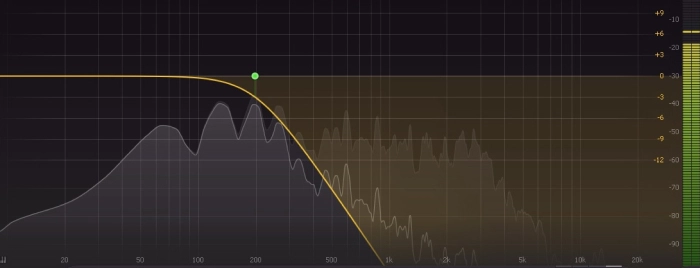
Depending on your bass guitar tone, the high cut frequency could be different from my bass tone.
For my sound, I chose 198Hz and cut everything above it. Find the best spot for your bass guitar and cut from that frequency.
Now you have a bass track with only low frequencies.
3. Duplicate DI Track And Apply HPF
The second step is to do the opposite and create mids and high frequencies. The process is the same but instead of a low pass, you need to high pass your tone.
Duplicate your bass DI track and instead of a low pass, apply a high pass filter. The frequency spot must be exactly the same.
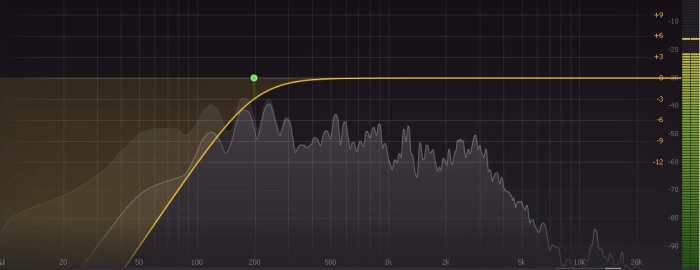
In my case it was 198Hz. So, I will add a high pass filter on that frequency point. You do the same. Choose the exact frequency that you had for the first track and high pass it.
Now you have your lows separated from mids and highs. It’s easier to mix DI bass guitar when you can control frequencies separately.
4. Compress Both Bass Tracks
It’s time to make low, mid, and high frequencies even and consistent. For that, you need to use any compressor plugin you like.
Add a compressor to both tracks and start compressing your bass track but don’t overdo it.
Choose between 2:1 and 3:1 ratios. It will be enough for most bass tones. For my bass guitar, 3:1 worked perfectly for both frequencies.
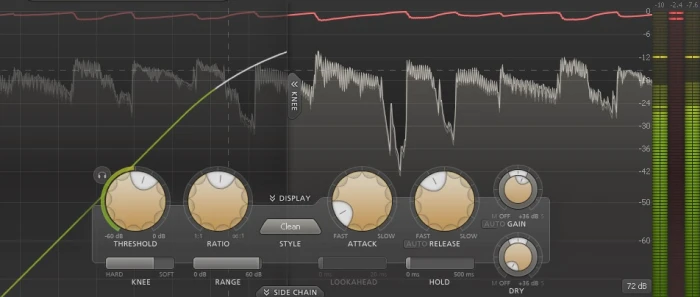
The goal is to mildly compress our bass guitar tracks. It helps to make them a little more consistent. No hard compression is needed here because we will compress the bass guitar later.
Every bass tone is different. Just listen to the sound, tweak your compressor, and find the best spot. Choose a low ratio, maybe a soft knee, and not too much threshold. Just enough compression to make the audio signal a little bit even.
5. Duplicate And Use Saturation
At this point, most of the hard work is done. You have two clean bass tracks. One has only lows and the other has mids and highs. Both are slightly compressed and the sound is balanced and even.
It’s time to add some coloration to it. And you can use any tool you like.
It might be a distortion, saturation plugin, or even a bass amp sim. The goal is to add some kind of coloration or amp sound.
This is an optional step to mixing DI bass guitars. If you want a clean bass tone, you can skip this step.
But a little distortion will help the bass to cut better in the mix. Also, it nicely folds high peaks and makes them smoother.
To add saturation to your bass tone, you need to duplicate the second bass track, the one that has a high pass filter. Leave the high pass and compressor as it is and add any saturation, overdrive, or amp sound.
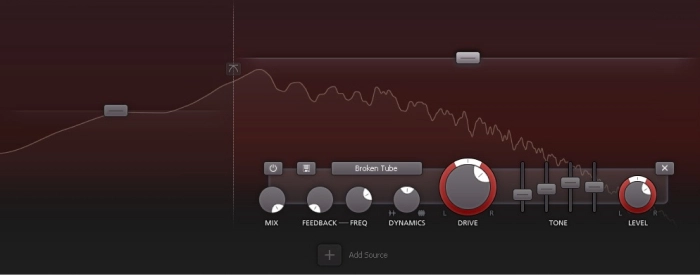
You need saturation on the second track because distortion works better on mids and highs. Also, the clean low end is much better sounding and easy to control.
The amount of distortion you add is up to you. Also, it depends on the type of saturation but you don’t need too much distortion. Just enough to make it a little overdriven.
Use any distortion or saturation plugin you like. Also, you can use any bass amp sim. It depends on personal preferences. The goal is to add some coloration and overdrive to the bass tone.
6. Blend Bass Tracks
Now you have three separate bass tracks. One with a clean low end, the second with clean mids and highs, and the third one has a distortion.
To properly mix the DI bass guitar you need to blend these three bass tracks together.
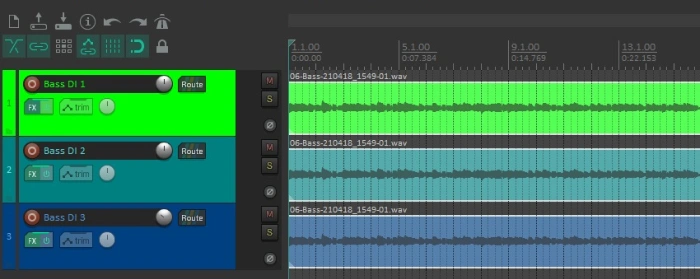
You do it with track faders and no plugins or fancy tools are needed. You just need to match the levels to your taste.
The first and second tracks should be on the same level. It must be like one track. So, make sure that your clean tracks are balanced because these two tracks are the main source of your bass guitar tone.
However, you need to blend the saturated track with the other two tracks.
Turn off the saturated track volume with the fader. Start playing the tracks and slowly start moving the fader higher.
Listen carefully and find the best spot where it nicely blends with the clean tracks.
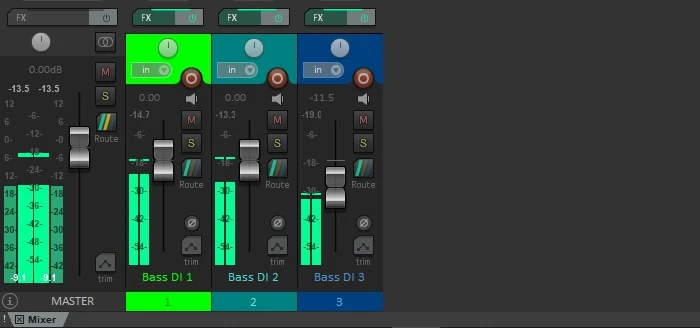
The goal is not to have a distorted bass tone. You just need to add some color to the tone which will help the bass to cut in a mix and high peaks become smoother.
You need to mix DI bass tracks in a way that the clean sound must be dominant. And saturated tracks should be underneath it. When you listen to it you have to hear that there is some distortion.
However, if your goal is to have a distorted sound, you can do two things. First, add more distortion to your saturated tracks. Second, blend it more and make it a little bit louder.
7. Send All Bass Tracks To Bus Track
It’s time to combine three bass tracks and make them one. Three separate tracks gave us the flexibility for more control.
Now it’s time to merge them and create our main bass guitar track.
To create the main bass track, you need a bus track. Some digital audio workstations may use AUX tracks for that. The goal is to connect three bass tracks to the same audio track.
In every DAW, you can send one audio track signal to another. Create a separate, empty audio track, give it a name like “Bass Bus”, and send all three bass track signals to that track.
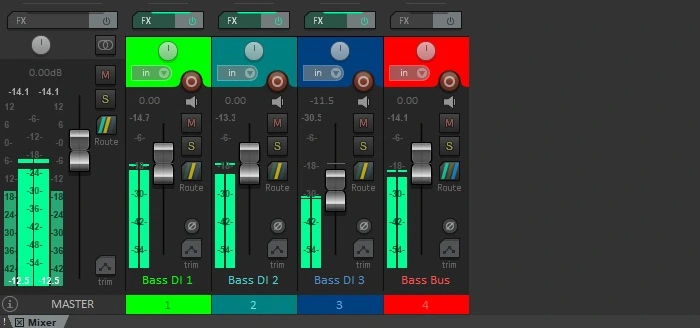
This bus track becomes your main bass track. It consists of three different signals but acts like one track.
Now, it’s time to start using EQ and compressor and mix bass guitar tracks.
8. Apply EQ To Bass Bus
The last two steps are for real mixing. The first step is to mix the DI bass guitar with EQ and you apply EQ to the bass bus track, not individual tracks.
Of course, EQ settings will be different for every bass guitar. Just listen to it and EQ your bass tone as needed.
First, apply HPF and LPF to remove unnecessary frequencies. Then, find the best-sounding frequencies in the low and mid sections and boost them. Here are my final EQ settings.

Your settings will be different. But as a general guide, the best tone for bass guitar is between 70Hz and 100Hz. You can cut everything below. It will free up space for a kick drum.
Also, depending on the bass tone, around 1kHz and 2kHz might be a good spot to boost. It will give a little grit to the bass tone.
You can find more information about bass frequencies from bass EQ cheat sheets.
9. Apply Compressor To Bass Bus
And lastly, to mix a DI bass guitar and make it final is to compress it. Like EQ, you apply a compressor on the bass guitar bus track and you compress it more than you did it on individual tracks.
The sound is already compressed but it needs more compression. It’s not completely even and balanced yet so, it requires additional compression for better results.
Just choose your favorite compressor and start tweaking the settings. Don’t use too much compression. About a 4:1 ratio will be enough.

After you set the ratio, choose the threshold. You need to compress high peaks. Find the best spot for the threshold. Where it starts compressing the highest peaks.
Add attack, release, knee, and other options depending on your bass tone. Listen carefully to how sounds are in the whole mix. But sometimes check in mono.
Conclusion
This guide about how to mix DI bass guitar tracks will help you to create awesome bass tones. You have more flexibility and control over your bass tone. DI tracks are great because of that reason.
Of course, there are many other methods for mixing bass guitars. This is specific to DI tracks. If you use real bass amps or VST plugins, there are different ways to mix them.
